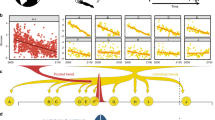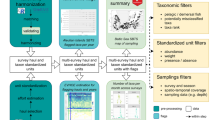Abstract
replying to T. A. Branch, D. J. Hively & R. Hilborn. Nature 495, 10.1038/nature11974 (2013)
Branch et al.1 suggest that the fisheries component of our ocean health and benefits index2 is ‘biased’. We contend that our approach is no more biased than their alternative, and that our method improves on theirs in three fundamental ways: it provides a score for every country, accounts for thousands of data-poor stocks, and incorporates sustainability more comprehensively.
Similar content being viewed by others
Main
Our global score is an area-weighted country average of a multidimensional assessment of sustainable food provision, fundamentally different from what Branch et al.1 interpret it to be, which undermines comparisons to their global estimate. They incorrectly state that our index should be roughly equivalent to dividing global catch by global maximum sustainable yield (MSY), and incorrectly interpret a score of 100 in our index as B = BMSY. They focus on single-stock biomass harvested relative to single-stock MSY, as in their Fig. 1, and assume that they know true MSY values. We used a multispecies reference point (mMSY) with a precautionary buffer that penalizes countries both above and below this value, and our focus was on fisheries within exclusive economic zone (EEZ) scales. Branch et al.1 focused on a single global assessment (of current status only), leading to a relatively small number of the largest fish stocks worldwide driving their interpretation. We chose to use catch data, available for all countries and most stocks, acknowledging the associated limitations and uncertainty of those data. Although their approach may be useful for assessments of global biomass production, and we agree it is preferable to use abundance estimates and other indicators rather than catch data when possible, reliance on such data precludes country-level assessments at the global scale.
By focusing their analysis on a geographically restricted data set of exclusively large commercial species (<5% of all stocks in the world), they assume that small stocks, and the many interactions they have with large stocks, do not matter for understanding sustainability, and that the many data-poor stocks are irrelevant to understanding food provision. Data-poor stocks represent ∼80% of all fisheries biomass and the vast majority of stocks in most countries. These stocks are in worse condition than assessed stocks, and getting worse3. Their selection of tuna and billfish as a counter example to our results focuses on an outlier; these large pelagic stocks are not representative of most fisheries within EEZs (that is, bottom-dwelling species or those taken in small-scale fisheries) or most unassessed stocks. Therefore, it is reasonable to assume that unassessed stocks would lower fisheries index scores, and for our comprehensive assessment to differ from the narrower one of Branch et al.1
Because of these key differences, strong correlations between our methods should not necessarily be expected. In addition, assessments made using best available data in individual countries should generate different outcomes compared with a global assessment where the focus is on using globally available and comparable data. We know that many country-specific scores will change as we improve the underlying data and our ability to predict sustainable yield of stocks around the world. Our index was explicitly designed as a framework that can ingest the best scientific information as it becomes available, whether as better data or improved approaches to measuring a goal, and in fact, we are doing just that as we apply the index at regional scales. Authors from both papers are currently collaborating with the Food and Agriculture Organization of the United Nations to examine how to improve methodologies for estimating fisheries exploitation status globally. We look forward to incorporating those results and improved data in future iterations of the index.
This Reply is written by the subset of authors that developed the fisheries component of the ocean health and benefits index2 relevant to the discussion in Branch et al.1.
References
Branch, T. A., Hively, D. J. & Hilborn, R. Is the ocean food provision index biased? Nature 495, http://dx.doi.org/10.1038/nature11974 (2013)
Halpern, B. S. et al. An index to assess the health and benefits of the global ocean. Nature 488, 615–620 (2012)
Costello, C. et al. Status and solutions for the world’s unassessed fisheries. Science 338, 517–520 (2012)
Author information
Authors and Affiliations
Corresponding author
Rights and permissions
About this article
Cite this article
Halpern, B., Gaines, S., Kleisner, K. et al. Halpern et al. reply. Nature 495, E7 (2013). https://doi.org/10.1038/nature11975
Published:
Issue Date:
DOI: https://doi.org/10.1038/nature11975
Comments
By submitting a comment you agree to abide by our Terms and Community Guidelines. If you find something abusive or that does not comply with our terms or guidelines please flag it as inappropriate.



